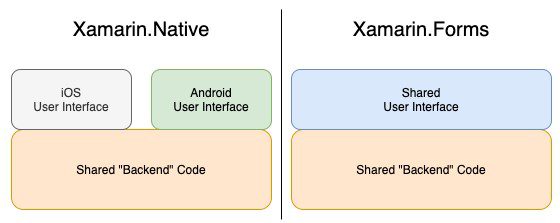In the ever-evolving landscape of app development, the advent of Xamarin.Forms has been a game-changer. Let’s dive into the intricacies of this open-source cross-platform UI development framework and explore how it reshapes the traditional approach. How does Xamarin.Forms work? Architecture Demystified Understanding the architecture is key to unleashing the power of Xamarin.Forms. The shared code […]
In the ever-evolving landscape of app development, the advent of Xamarin.Forms has been a game-changer. Let’s dive into the intricacies of this open-source cross-platform UI development framework and explore how it reshapes the traditional approach.
How does Xamarin.Forms work?

Basic difference between Xamarin.Forms and Xamarin.Native
Architecture Demystified
Understanding the architecture is key to unleashing the power of Xamarin.Forms. The shared code resides in a .NET Standard library, while the platform-specific applications consume this shared code. The App class, along with AppShell, defines the visual hierarchy, and platform renderers convert cross-platform UI elements into native controls at runtime. It’s the magic behind achieving native look, feel, and user experience while sharing code.
Benefits of Xamarin.Forms
Efficiency Redefined
Xamarin.Forms allows developers to create native UI layouts and designs across platforms using a single shared codebase. This not only saves time and money but also facilitates code, test, and business logic sharing. Reports suggest up to 95% code sharing, making it a compelling choice for projects where code sharing takes precedence over custom UI.
Supported Platforms in Xamarin.Forms
Beyond the Basics
Xamarin.Forms isn’t confined to the big three—iOS, Android, and Windows. It extends its support to platforms like Samsung Tizen, macOS, GTK#, and WPF, opening doors to diverse application possibilities. However, it’s crucial to keep platform-specific requirements in mind, ensuring optimal compatibility.
Essential Terms in Xamarin.Forms
Building Blocks of UI
To navigate the Xamarin.Forms terrain, one must be acquainted with key terms. Views, layouts, effects, gestures, and triggers form the vocabulary. These elements play pivotal roles in shaping the user interface, allowing developers to craft engaging and interactive app layouts.
Key Building Blocks of Xamarin.Forms
The Foundation of Functionality
Delving deeper, Xamarin.Essentials, XAML, behaviors, and data binding emerge as the foundation of Xamarin.Forms applications. Xamarin.Essentials offers a cross-platform API, XAML provides a concise UI creation language, behaviors add functionality to controls, and data binding ensures synchronization—a quartet essential for robust app development.
Code-Sharing Techniques in Xamarin.Forms
Strategies Unveiled
Code sharing is Xamarin.Forms’ forte, and it offers two main methods: .NET Standard Libraries and Shared Projects. Whether opting for a broad API coverage or a specific set of platforms, Xamarin.Forms provides flexibility. Portable Class Libraries, though deprecated, offer an alternative for developers with specific platform preferences.
Platform-Specific Features and Creation
Tailoring for Uniqueness
Each platform has its nuances, and Xamarin.Forms accommodates them through platform-specifics. These features, distinct to a particular platform, can be seamlessly integrated using effects. Learn the steps to create platform-specific features, enhancing your app’s capabilities without compromising cross-platform compatibility.
Shortcomings of Xamarin.Forms
Navigating Challenges
While Xamarin.Forms excels in many aspects, it’s not a one-size-fits-all solution. Developing complex apps with intricate native functionalities may pose challenges. Additionally, the file size of Xamarin.Forms apps can be larger compared to native counterparts. Understanding these limitations helps in making informed development choices.
Getting Started with Xamarin.Forms: A Beginner’s Guide
Embark on Your Journey
For beginners, Xamarin.Forms offers a treasure trove of resources. From official documentation to tutorials, code samples, and an active community, the learning curve is gradual. Embrace Xamarin.Forms Shell for a streamlined app development experience, featuring a common navigation user experience and an integrated search handler.
Conclusion
In conclusion, Xamarin.Forms emerges as a powerful ally in the realm of cross-platform development. Its ability to balance code sharing with native UI intricacies makes it a go-to choice for developers aiming to conquer multiple platforms seamlessly.